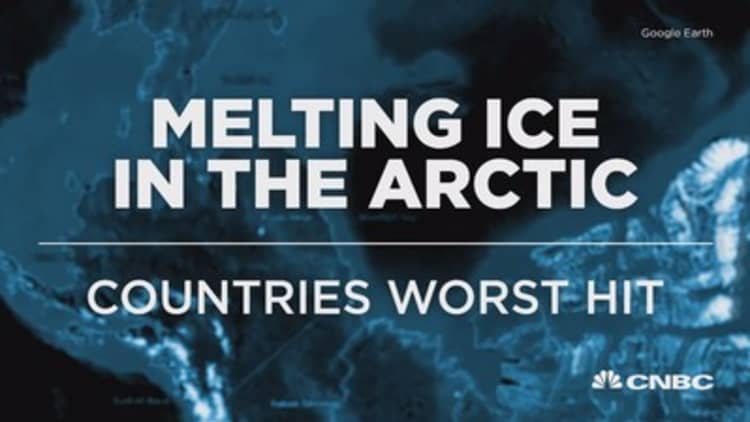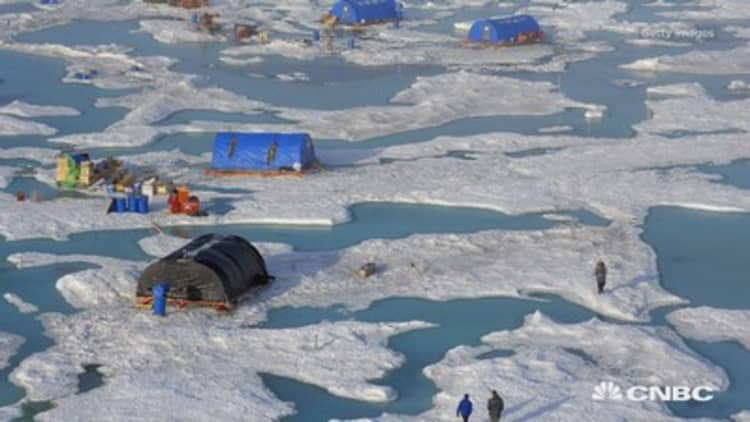The race to claim stakes in the melting Arctic is heating up. That's because a quarter of the world's energy reserves are at play.
Standing 12,000 feet high and stretching more than 1,000 miles, the Lomonosov Ridge very well might be the most important mountain range most people have never heard of. Submerged beneath sea ice and the frigid Arctic waters, the geological peculiarity sits just a few hundred miles from the North Pole, and according to the U.S. Geological Survey the Lomonosov Ridge and areas surrounding it could hold a quarter of the world's remaining fossil fuel reserves—90 billion barrels of oil and more than 1.5 trillion cubic feet of natural gas worth an estimated $17.2 trillion.
In early August, Russia reasserted its claim to the North Pole and surrounding region that includes part of the Lomonosov Ridge, portions of which are also variously claimed by Denmark and Canada. That amounts to over 463,000 square miles of Arctic sea shelf extending more than 350 nautical miles from the shore. It submitted a bid for these vast territories to the United Nations. This latest push by Russia to expand its claim on the Arctic has not unfolded in a vacuum. Record seasonal losses of Arctic sea ice increasingly open up new navigable sea lanes while also threatening ecosystems there. Potentially vast oil and gas reserves have grown increasingly accessible, luring both governments and energy companies into Arctic waters.
And as tensions between Russia and the West approach Cold War intensity, a massive military buildup along Russia's Arctic coastline underscores the geostrategic value of a region that's become a 21st-century hotbed of high-tech espionage and military competition.

The race for the Arctic is on in more ways than one, creating new environmental, human and geopolitical risks in one of the world's most inhospitable environments—one in which no nation is fully prepared to operate. Consequences to the future of our planet are huge. This month researchers in Sweden published a study showing how melting sea in the Arctic is encouraging methane emissions—exacerbating climate change and the warming of the atmosphere. That's because the ice acts like a windshield reflector to the sun's warming rays, and without it the oceans absorb more heat.
According to a recent scientific study by Cambridge University and the U.S. National Snow and Ice Data Center, this climate change will add an extra $43 trillion of cost to the global economy by the end of the next century.
Beyond environmental concerns, the other, larger question surrounding the Arctic isn't so much whether the region's resources should be developed but whether corporations and nations can do so safely, cooperatively and peacefully.
The next flash point
"For the last 25 years the Arctic has been a place of international cooperation," said Heather A. Conley, director of the Europe Program and an Arctic policy expert at the Center for Strategic and International Studies. "And we don't have an idea of what it will be when it's not a place of international cooperation."
The Arctic is warming twice as fast as the rest of the planet—so fast that NOAA scientists believe much of the Arctic could be free of ice in summers by 2050, allowing ships freedom of movement across the entire Arctic Ocean. Previously unnavigable sea lanes are already opening across the Arctic in summer. Only four cargo vessels traversed the so-called Northeast Passage—a shipping lane across the northern shore of the Eurasian continent, connecting Atlantic to Pacific—in 2010. By 2013 that number had grown to 71.
Energy exploration and exploitation has also increased. State-owned energy companies like Russia's Rosneft and Norway's Statoil have made exploratory forays into the Arctic, while Royal Dutch Shell and ConocoPhillips (as well as Statoil) have drilling leases off the coast of Alaska, where 30 billion barrels are thought to be lurking in the Beaufort and Chukchi seas.
Increased activity in the Arctic has brought more companies, more government entities and ultimately more people into an Arctic environment that remains one of the world's most challenging in which to operate. Increased economic activity and human presence has sparked fears of both environmental disasters and military escalation as the five states with Arctic borders—Russia, Canada, Norway, the United States and Denmark (through its self-governing territory Greenland)—attempt to bolster their security postures there.
Russia, resources and riches
Of those states driving the increased military tempo in the Arctic, Russia has taken a clear lead, reopening Soviet-era airfields and naval bases and conducting large-scale military exercises in the region. In March, the Russian military conducted a complex series of unannounced military maneuvers in the Arctic, involving more than 200 aircraft, 41 warships and 15 submarines and over 40,000 troops. The Russian Defense Ministry has acknowledged that it has been flying reconnaissance drones regularly over the region since at least May, and Russian state media reports that two Russian contractors are developing a new "heavy drone" specifically for use in the Arctic.
Next year Russia's Northern Fleet—the nation's most powerful Navy formation—will become the backbone of its new Arctic Command, with its area of engagement, including the high-latitude areas of the Arctic Ocean and the North Pole, Tass has reported. It includes nuclear missile submarines and other warships.
"What we've really seen over the last 12 to 18 months is a different posture focusing on their strategic nuclear deterrent, unannounced military exercises, a lot of opening of new bases and positioning of military personnel and equipment—all of which seems much more significant than what would be required for enhanced search and rescue or oil spill response," Conley said, adding, "So I think we are seeing an important evolution in Russia's militarization of the Arctic, and that needs to be assessed by the other Arctic states for sure."
But military posturing aside, experts say the risk of actual military confrontation in the Arctic is likely overblown. Russian territorial claims in the Arctic, coupled with the uptick in military activity, have provoked headlines that don't necessarily measure up with reality, said Admiral Robert J. Papp, a former commandant of the U.S. Coast Guard now serving as the U.S. State Department's special representative for the Arctic.
"This is the second time Russia has submitted its claim," Papp said of Russia's most recent territorial claim made under the United Nations Convention on the Law of the Sea. He added: "It's doing so under an orderly process prescribed by the U.N. They complied with everything they had to comply with, and yet a big deal was made of it. So I think sometimes they don't get a fair shake on these things."
That said, Papp concedes that the Russian state has brought a certain degree of distrust upon itself through recent actions in Ukraine and a rhetoric that has escalated tensions with the West. It's this kind of bigger-picture geopolitics that makes the militarization of the Arctic more troublesome to many security experts. A risk assessment published in May by The Arctic Institute notes that even though military activity in the Arctic is at its highest point since the Cold War, the risk of military conflict over the Arctic remains low. However, the risk that the Arctic could become a potential theater in a larger conflict between Russia and the West remains very real.
"I think that Russia is worth watching," Papp said. "We need to be cautious; we need to be curious about what they are doing up there. But we don't need to overreact."
Is a cold war brewing?
In building up its military presence along its northern shore, Russia is both attempting to solve and exacerbate a problem shared by all of the Arctic-bordering states. More commercial and military activity in the Arctic means more people in the Arctic. More people in the Arctic means more risk in the Arctic—risk of environmental accidents, of military accidents, of stranded vessels, of human safety. The greatest risk in the Arctic today isn't any one of these, but the fact that no nation has made developing its Arctic capabilities a priority even as activity in the Arctic increases.
"The greatness of any maritime nation can be measured by the resources it provides for the safety of mariners that approach its shores," Papp said. "We've done that well for the continental United States for a couple of centuries. But now we have a new ocean that we're responsible for in the Arctic and the upper Bering Sea, and we have not provided the same number of resources, even though human activity is increasing."
For instance, the distance between where Royal Dutch Shell is drilling in the Chukchi Sea and the nearest safe harbor in Dutch Harbor, Alaska, is some 800 to 900 miles, Papp explained. "There is no deep-water harbor of refuge up there to get out of the weather, or to prestage or set up a forward operating base. The infrastructure is very limited."

The U.S. Coast Guard got a good look at the challenges presented by commercial activity in the Arctic in 2012, when a Shell-operated drilling rig caught in high seas had to be abandoned, its crew evacuated by Coast Guard helicopter. The drilling rig was left adrift with nearly 150,000 gallons of diesel fuel and more than 10,000 gallons of other hazardous fluids aboard. The drilling rig later struck a barrier island, but its tanks didn't rupture. Through sheer good luck, environmental disaster was averted. Neither Shell nor the Coast Guard had resources in place to adequately deal with the situation.
America's posture
"There's just an incredibly scarce amount of capability in the Arctic, even to conduct adequate search and rescue," Conley said. While the Russians have the most military hardware and personnel on hand, soft security assets—those aimed at things like environmental, commercial and civilian security—are scarce or nonexistent. Communications satellites, icebreakers, aircraft and the forward operating infrastructure that would make use of such things are all lacking.
Where the U.S. is concerned, something else is sorely lacking in the Arctic: a strategy. While the Obama administration published a national Arctic strategy in May 2013 and an Obama implementation plan for the strategy the following January, both documents largely consist of detailed to-do lists rather than concrete line items in a federal budget.
"The problem is, talk is cheap," Conley said. "No one is putting the resources or developing a multiyear budget that says this is how we are going to prepare for the Arctic. Everyone agrees that there's rapid change; everyone agrees that we need to monitor, assess, evaluate. But when it comes to the significant budget needs for a deep-water port in the American Arctic—or ice-breaking capability, or aviation assets, or satellite communications—everyone kind of looks at the floor and says, 'Not my budget, thank you very much.'"
During a visit to Alaska at the beginning of September, President Obama addressed the impact of climate change on America's Arctic-bordering state. He criticized Arctic oil drilling and warned that the meltdown threatens to annihilate cities, animal species and force migration. Then he announced plans to invest in ice breakers and other safety and security measures in the Arctic to shore up readiness due to heighten risks. Right now the U.S. Coast Guard owns just two functioning ice breakers; Russia possesses a fleet of 41, with plans to add 11 more.
Time will tell how fast the U.S. will respond to the crisis—and the increase of commercial and military activity it enables. And as development in the Arctic increases, so do those associated risks.
"If we have a major incident in the Arctic, it's going to demonstrate our limited capabilities and the difficult operating environment, and unfortunately, as the crisis unfolds, we're all going to be looking around wondering why we don't have more access," Conley said. "It's going to be an education we all don't want."
—By Clay Dillow, special to CNBC.com











